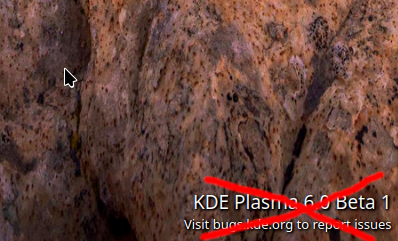Official Linux RSS about stable kernel releases: https://www.kernel.org/feeds/kdist.xml
It's illegal in Europe to have an opt-out checked by default, must be an opt-in unchecked by default. This is one of the reason that Microsoft has always troubles in Europe about privacy and opt-out services.
Hahaha. Common problem with multiscreen with different resolutions. Your laptop screen is below and left of your main display, and X11 renders this black "virtual screen".
There are multiple solutions:
a) Set your screen resolution and position through KDE Plasma SystemSettings and push the button "apply to SDDM configuration" (I think Plasma 6.0 removed this option, try to find it in the SystemSettings KCM SDDM section).
b) The another solution is the old one. Create a file into /etc/X11/xorg.conf/display.conf with the proper values of position and resolution. Search in a wiki about examples (archlinux wiki?).
c) There is a third one that I used few years ago. SDDM allows you run any command after the screen initialization. So you can exec your xrand command here. Search about /etc/sddm.conf
I think that the reason is the same for "why is XMPP mentioned more than IRC?". IRC has more clients, it's less resources hungry and simpler than XMPP.
I think that the reason is because it is old-fashione, and it's clients feel outdated and (native) "lacking features" compared to more popular clients like Discord, WhatsApp, Messenger, Telegram or Signal. 🤷♂️
I can imagine my cousins using any of the clients I mentioned before, but not IRC, XMPP, or any protocol from my era. Life and traditions, isn't it?
The last year 2023 was incredible (providing a lot of good games).
Fils Aime: ‘Thank you, but I want more.’ ‘Thank you, but give me more.’ I mean, it is insatiable. 2012 https://kotaku.com/the-trouble-with-the-never-satisfied-gamer-5920572
#!/usr/bin/env bash
A folder dotfiles as git repository and a dotfiles/install that soft links all configurations into their places.
Two files, ~/.zshrc (without secrets, could be shared) and another for secrets (sourced by .zshrc if exist secrets).
localhost
- Factorio (currently best management)
- Satisfactory (cozy Factorio)
- Captain of Industry (try this one)
Maybe this functionality was replaced by the next thing?
Automatic root filesystem soft-reboot: systemctl automatically reboots into a new root filesystem located at /run/nextroot/.
Developed by Saber Interactive. Caution.
Caution disabling mitigations. Only enable on air-gap devices (devices without any connection, airplane mode).

TLDR; the reviewer is upset because the PSVR2-PC adapter doesn't come with a Display Port cable, and his Bluetooth adapter is not compatible. So he can't review the unit on time until he receive both items. 🤷